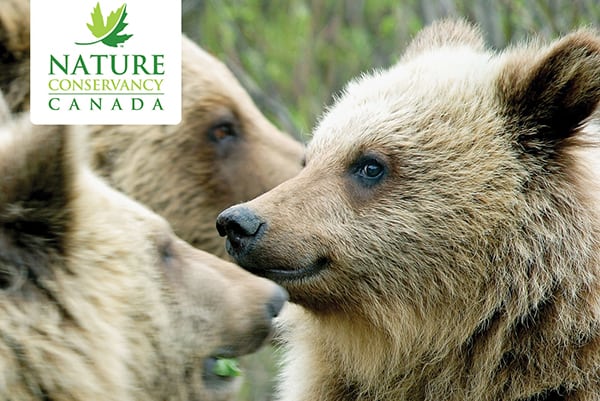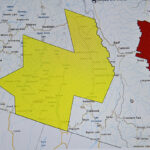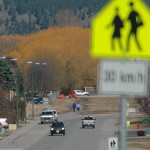Home »

Nature Talks: The Grizzly Bear
By Anne Jardine
Over 200 nature lovers flocked to Invermere’s community centre for a Nature Conservancy of Canada (NCC) presentation on grizzly bears Thursday, September 6.
The event was part of NCC’s series of Nature Talks.
To honour the land, the evening opened with an ancient bear legend recounted by Ktunaxa storyteller Bonnie Harvey.

The evening’s main speaker was Dr. Michael Proctor, the lead Canadian researcher in the Trans-border Grizzly Bear Project. He is a contributing member of several international science organizations dedicated to bear research and conservation. Starting with the big picture, he used maps to show the worldwide ranges of grizzly bears. They range over most of Asia and Russia, and western North America, but they are extinct in the southern hemisphere.
Then he zoomed in to recent research on grizzly populations in the Yukon to Yellowstone corridor, mainly focusing on his own work in the South Selkirks, in and around Darkwoods (one of the Nature Conservancy’s important habitat acquisitions located to the north of Salmo and Creston).
For over 25 years, Proctor has been tracking and mapping the seasonal movements of grizzlies across their ranges. Their habitat spans all elevations from wet valley bottoms to high alpine and each bear can cover areas of hundreds of miles. Grizzlies once ranged all over western North America from deep in Mexico to the northernmost areas of Alaska and Canada, but due to the expanding human footprint, they have become extinct in Mexico and the southwestern states, and fragmented in the northwestern states.
“Why care about grizzlies?” Proctor asked. “There are more reasons than you might expect. Of course, I got drawn in because they’re cool and interesting. They’re expansive, and a little dangerous. But everyone should care about grizzlies because it’s their world too. They share our habitat. There are also deeper ecological reasons to care. Grizzlies are great seed dispersers, strengthening the plant life in their territories. Through predation, they help keep other animal populations in balance. They are an umbrella species, meaning that if they are healthy, then many other species that support them are also in good shape. They are an indicator species. They make their living in healthy wild habitats. If they are healthy, then that indicates the land base is too.”
Proctor went on to explain the three main issues that threaten grizzlies:
Habitat fragmentation and loss of connectivity means they cannot move from one area of food source to another because of human encroachment and walls of mortality, or in other words, roads – Highway 3 being one of the most deadly for his particular population. The solution is to create ways for the bears to move over or under the roads, or to remove the roads entirely.
“We have been quite successful in removing (mostly forestry) roads in and around Darkwoods,” he said.
Human caused mortality includes highway accidents, and deliberate killing by hunters, and also by ranchers and farmers trying to protect their livestock. The solution here is retraining bears, people and agencies. One important tool is electric fencing, has worked amazingly well with subsidies from the Nature Conservancy to help farmers with the costs.
 Habitat quality and security has to do with protecting the prime food sources for the bears. Of course, huckleberries and buffalo berries are their main diet. The bears need big, dense patches of berries so as not to waste their time and energy. Removing roads has helped keep people and commercial enterprises from competing with the bears for their food. Another solution that enhances bear survival rates is protecting linkages between prime food sources so the bears can more easily move about and make a living.
Habitat quality and security has to do with protecting the prime food sources for the bears. Of course, huckleberries and buffalo berries are their main diet. The bears need big, dense patches of berries so as not to waste their time and energy. Removing roads has helped keep people and commercial enterprises from competing with the bears for their food. Another solution that enhances bear survival rates is protecting linkages between prime food sources so the bears can more easily move about and make a living.
Proctor concluded, “I believe that once you identify a problem, then you make a plan to solve it. You create baseline observations, implement the plan, and then measure what changes. We still have healthy grizzly populations in Canada, and a few in the United States. We want to make sure they have the best possible conditions to survive and thrive. We have been making progress.
“We can measure our success in a couple of ways. Mortality statistics have been dropping since 2005. And there are more healthy female bears within our study area. In 2004 there were no female grizzlies in the linkage areas of our study. In 2017 there were seven females. Females are important to track because they give birth to and raise the offspring. Females insure the future growth and survival of the population. We have some reasons to celebrate that our plans are working.”
Before opening up questions from the audience, Proctor had one important comment: “None of this would have been possible without the Nature Conservancy. They work to make sure there is a land base, and linkages between habitats.”
One member of the audience asked Proctor about the average life expectancy of a grizzly. He responded, “They can live an average of 20 years. The oldest one we’ve found died at age 37, but he was exceptional. You can determine age by the teeth, which have layers that can be counted like the rings of trees.”
Another question had to do with bans on huckleberry picking, especially by commercial companies. Proctor praised the leadership of the Ktunaxa people in their advocacy for regulations, “They recognized immediately the need for some management of people and their competition for the food supply within the bear country.”
A third audience question had to do with the effects of fire and forest practices on the grizzly habitat.
Proctor explained, “Of course, wild fire opens the canopy and allows for huckleberries to thrive. And clear-cutting can do that too. There is a lot of research being done on prescribed burns. There are a few problems to work out, though. In terms of reforestation, forest companies want to have trees grow fast. Biologists want to have trees grow slow.”

The last question was about one of Nature Conservancy’s most recent local acquisitions, the Luxor Corridor.
Proctor commented, “That is out of my area of study, but I know it connects two very healthy habitats in the Columbia wetlands and in Kootenay National Park. Bear populations in both areas are doing well, but the acquisition will insure that continues to be the case.”
The evening ended with a brief thanks from local biologist Nancy Newhouse to special guests Bonnie Harvey and Dr. Michael Proctor, to Michael Curnes and his team of Nature Conservancy local event volunteers, and to major sponsor Kicking Horse Coffee.
For more information about the NCC, which has, since its charter in 1962, purchased and protected more than a million acres of critical habitat across Canada, visit their website, or their Invermere office, which has excellent maps and outlines of local projects.
Lead image courtesy NCC







